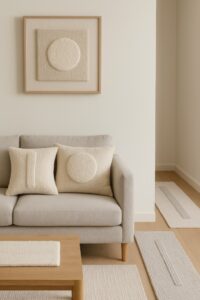Your brain is juggling tabs all day. You close the laptop, but the thoughts keep scrolling. Here’s a small, tactile antidote you can feel working within minutes: punch needle. It’s a beginner-friendly craft that turns simple loops of yarn into soft, sculptural decor—pillows, panels, pouffes, hats also gives your nervous system something steady to hold. The rhythm is repetitive in the best way, the results come quickly, and the finished pieces quietly soften a room.

This guide shows you how to match punch needle projects to three popular interior styles—boho, scandi, and minimalist—so your hobby becomes a daily stress reducer and your home gains calm, cohesive texture. You’ll learn why this craft is so soothing, what colours and patterns support each look, and how to set up a low-friction routine that fits real life with real-time limits.
Why punch needle helps you de-stress (and how to set up a ritual that sticks)
Stress hates rhythm and boundaries; punch needle gives you both. The hand movement is cyclical and predictable, much like knitting, but with faster visible progress. Each small patch you fill creates a tiny “win” your brain registers, which is encouraging when the rest of the day feels open-ended.
Start by creating a 10-minute ritual. That’s it—ten minutes. Keep a small kit in a basket by your favourite chair: a hoop, a monk’s cloth, one needle, two yarns you love by touch. Decide on a finish line before you begin. Setting a micro-goal keeps the session contained so you end on calm, not on guilt for “not doing enough.
Match your supplies to your temperament. If you crave ease, use a pre-printed pattern. If you decompress by exploring, start with a blank cloth and sketch soft shapes directly on the fabric with a washable marker. Pick yarn for feel first and colour second—if it’s scratchy in your hand, it won’t be relaxing after 30 minutes.
When your day feels overfull, starting is the hardest part. That’s why needle punch kits are such good allies: everything you need lands in one box, so you can spend your energy making—not hunting for tools. The setup takes minutes, the rhythm kicks in fast, and you get a visible win before your tea cools.
Boho. earthy layers that invite you to exhale
Boho interiors are a hug made of colour and texture—great for unwinding after a long day. The aim here is warmth and ease, not precision. That permission to be imperfect is part of the stress relief.
Open with colour. Think terracotta, rust, mustard, sage, blush, warm beige. These tones echo clay, woven baskets, and late-afternoon light. They’re forgiving on the eye and pair well with plants and wood. Choose wool or wool-blend yarns for plush loops you’ll want to touch. Vary pile heights to create gentle relief; let one motif rise slightly above the background to add depth without fuss.
Patterns should flow. Arches, sunbursts, folk florals, and loose geometrics all fit. If lines wobble, leave them. The organic vibe reads intentional in boho, and the lack of perfection is a relief in a life full of deadlines.
Projects that land fast wins:
- round floor cushion for a meditation corner. Two or three sunburst arcs, mixed loop heights, finished with a simple fringe.
- plant-pot sleeve to warm a shelf. A small band of mustard and sage transforms a basic terracotta pot.
- wall trio in 10–12″ hoops. One arch, one circle, one abstract bloom; hang vertically to soften a narrow space.
Styling is stacked and relaxed. Layer your punch needle piece with a macramé hanger, a rattan mirror, or a vintage frame. Group items in odd numbers. Let the textures overlap a little—visual closeness fosters a cosy mood.
Boho stress-saving tip: pre-sort your yarn into small wound balls so you can switch colors without wrestling a bulky skein. Small touch, big ease.
Scandi. bright order that clears visual noise
Scandi design is a reset button for the eyes—light, airy, functional, and kind. If visual clutter wears you down, this style turns down the volume while keeping rooms friendly.
Begin with a soft, bright palette: off-white, oatmeal, light grey, and a rinsed-out pastel for a single accent. Add tiny black notes for crispness—thin lines, small grids—so the space feels intentional, not washed out. Choose cotton or fine wool in low to medium pile to keep edges tidy and easy to clean.
Patterns should soothe, not shout. Try stripes, grids, checkerboard, or half-moons. Leave plenty of negative space so the texture can breathe. That space is part of the calm; it gives your eyes a resting place.
Projects that bring function and comfort:
- lumbar pillow for desk or dining chairs. A thin grid in black on oatmeal cotton supports posture and adds subtle rhythm.
- entry bench pad with wide cream stripes. Softens the hello-and-goodbye ritual of the day.
- paired 12″ panels above a console. One half-moon, one stripe set; framed in light wood or white.
Keep finishes crisp. Block finished pieces by misting lightly with water, pinning to square on a towel, and letting them dry fully. This small habit prevents curling edges—the kind of tiny annoyance that can nag at you every time you walk past.
Scandi stress-saving tip: frame panels behind glass if they live in high-traffic areas. The texture still reads, but lint and dust can’t stick, which means less maintenance buzzing in.
Minimalist. quiet texture that slows the room
Minimalism isn’t about scarcity; it’s about choosing a few things that do a lot. In high-stress weeks, fewer decisions and fewer visual inputs feel merciful. Texture lets a minimalist room stay warm without adding noise.
Choose a tone-on-tone palette—bone, sand, dove, charcoal. Keeping to one family simplifies shopping and styling, and it looks restful. Aim for uniform low pile with small high-pile accents to create gentle, sculptural relief. This contrast reads like shadow and light rather than pattern on pattern.
Patterns should be singular and considered: one oversized circle, a single line motif, or a large field with a raised stripe. Place shapes off-centre to add interest without clutter. The negative space is the point—let it do the calming.
Projects that hold a room:
- one large framed panel above a sofa. Sand background with a raised bone circle set in the lower third. Thin black or natural oak frame.
- paired identical cushions in bone with a raised stripe. Symmetry soothes; pairs bring steadiness to a sofa or bed.
- narrow hallway runner in dove grey with a single lengthwise raised band. It guides the eye and slows foot traffic.
Minimalist stress-saving tip: invest in a sturdy frame or stretcher bars. Clean lines and square corners make the piece feel composed, which is half the effect of minimalism.
Placing, caring, and keeping the habit light
Projects feel soothing during the making and long after, if you place and care for them thoughtfully. Put high-pile, touchable items where your hands land naturally: the arm of your reading chair, the spot where you sit to lace shoes, the bed corner you reach at night. Keep low-pile pieces in entryways and kitchens for easier upkeep. Avoid splash zones for wool unless you plan to seal the surface.
Care is simple: lint roll weekly, spot clean promptly, and rotate cushions every few weeks so wear distributes evenly. Cotton tolerates more scrubbing; wool rewards gentler handling with longer life.
Keep momentum with a two-kit system. One project is mid-make, one is ready to start. On tough days, the decision to begin is the hardest part; having a backup project removes that barrier. Store both in a clear box with scissors, needle threader, and a small measuring tape so everything is always where you need it.
If you live with pets, elevate. Wall panels and shelf-height accents offer all the texture with none of the “cat discovered the pouffe” drama.
Conclusion: loop by loop, you make a calmer home
When you need a daily off-switch, punch needle gives your hands a rhythm and your rooms a softer voice. Boho wraps the evening in warm layers, scandi clears visual noise with light and order, and minimalist steadies a space with quiet relief. Pick the lane that matches how you want to feel and start small: a cushion, a panel, a plant sleeve. Ten minutes tonight, ten more tomorrow. The loops add up—to finished pieces you’re proud of and to a home that helps your nervous system rest.





